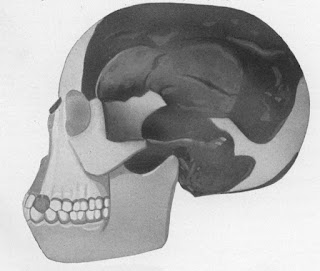Focus on reality (not on Piltdown)
 |
| Piltdown reconstruction (Wikimedia) |
I spent a few minutes recently reading comments on the Is Genesis History? Facebook page. I was struck by how many people who commented on my human origins video are obsessed with Piltdown. So let's take a deep breath (OK, I need a deep breath) and sort this out. What is Piltdown? Why does it matter?
In 1912, an "amateur archaeologist" named Charles Dawson reported to the Geological Society of London that workman in Piltdown (south of London) had recovered human remains from a gravel pit. Subsequent digging turned up remains of a skull that was said to be a primitive form, something of an "ape man." Forty years later, the remains were decisively exposed as a fraud. Someone had doctored the jaw of an orangutan and combined it with a human cranium, giving the appearance of a mix of ape and human features. The most likely culprit was Charles Dawson himself, a lawyer with a history of fraudulent archaeological "discoveries." So as it turns out, Dawson wasn't so much an "amateur archaeologist" as a serial liar and con artist.
So what does this fake fossil have to do with real hominin fossils like the Dmanisi discoveries or Homo naledi? I think creationists who continue to bring up Piltdown do it for one of two reasons. Piltdown makes scientists look stupid for not catching a fraud or look devious for committing a fraud in the first place. In other words, you can't trust an evolutionist because they're stupid or liars. No one ever connects those dots though. They just say, "Look at Piltdown. It's a fraud!" and leave the reader to draw their own conclusions. If they did spell out exactly what it means ("you can't trust an evolutionist"), we'd see right through it. It's a classic ad hominem attack, and it has nothing to do with actual hominin fossil evidence.
Let's focus on reality: Piltdown was exposed almost 65 years ago now. Most of the fossils that occupy the attention of modern paleoanthropologists were discovered after Piltdown was exposed. Real hominin fossils have received far more attention from far more conclusive tests and experiments than Piltdown ever did, and they are not frauds. Scientists could be wrong about their significance, but it's not for their lack of knowledge or understanding. To modern paleoanthropology, Piltdown is a historical curiosity.
Now, I could see Piltdown standing as a warning against confirmation bias. That's what Charles Dawson was probably banking on: scientists expecting to find evidence of human evolution would be so excited about this manufactured "discovery" that they accepted it without careful investigation. That could indeed be a reasonable warning, but it's a warning that everyone should heed.
Because Piltdown has a lot in common with Paluxy. Remember Paluxy? The river in Texas where supposedly human footprints were found alongside dinosaur footprints? It seemed like a dream come true for creationists: proof positive that dinosaurs co-existed with humans! Except those prints were just partially infilled footprints from other dinosaurs walking in soft mud. It took decades before creationists accepted this, and there are unfortunately still creationists who stubbornly refuse to accept the reality of Paluxy.
The lessons of Piltdown and Paluxy are indeed worth heeding today, because they are lessons for us all. We ought to be cautious and careful about discoveries. We need to be aware of our own biases and talk about them. Don't get too excited, especially when discoveries seem to corroborate your own opinions. That's the time to be even more skeptical. Most important of all, these lessons apply to creationists and evolutionists. No one is immune from confirmation bias.
So please stop obsessing over Piltdown. It doesn't mean anything to the modern science of paleoanthropology, and what lessons we can learn from it should make us all more careful and astute scholars.
Feedback? Email me at toddcharleswood [at] gmail [dot] com. If you enjoyed this article, please consider a contribution to Core Academy of Science. Thank you.